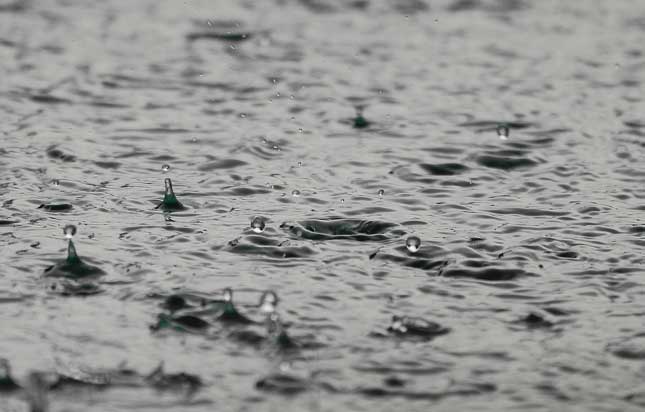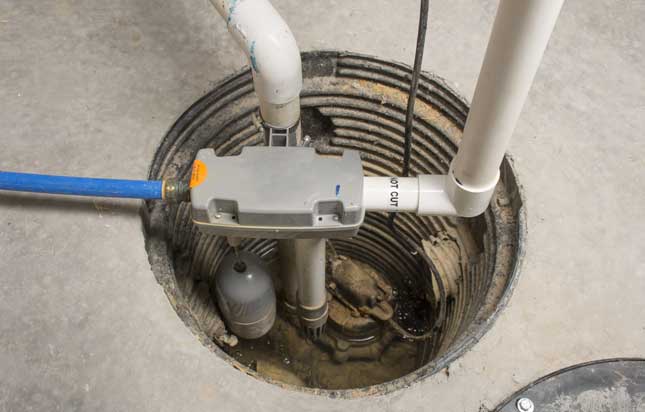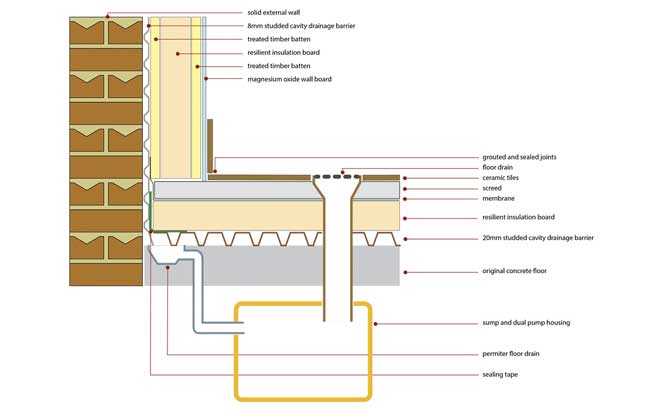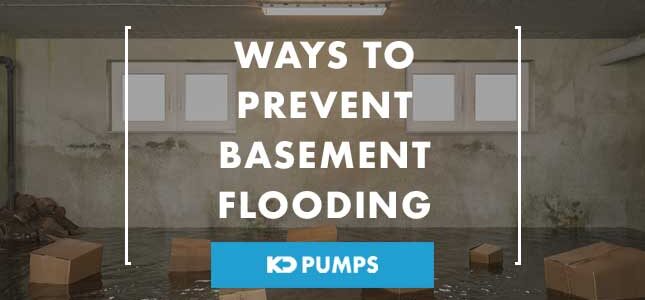9 Ways to Prevent Basement Flooding
Basement flooding is a common problem faced by many homeowners.
It can be caused by a number of factors, including natural disaster, poor drainage, and plumbing problems just to name a few.
In this article, we’ll discuss the primary causes of basement flooding and how to prevent future flooding problems.
Article Chapters
Causes of Basement Flooding

Heavy Rainfall. Image credit: Pixabay
Basement flooding occurs for a number of reasons which includes:
Location
Basements are very prone to flooding due to being set below ground level.
This makes them especially vulnerable to water seepage and accumulation, especially if below the water table during heavy rainfall or snowmelt.
If the surrounding area does not have a suitable drainage system in place, water can accumulate around the foundations and easily seep into the basement.
Heavy Rainfall
A common cause of basement flooding is heavy rainfall.
If your home is located in an area with poor drainage, water will accumulate and seep into the basement area.
Heavy rainfall will overload your gutters and downspouts, causing them to overflow and flood the basement.
Poor Drainage
If the ground surrounding your property is not sloped away from the foundations, water will accumulate and seep into your basement.
Similarly, if your home is located below the water table, it will be susceptible to flooding during heavy rainfall or snowmelt.
Faulty Plumbing
Plumbing issues can cause basements to flood.
If your sump pump fails to activate, water will accumulate in the sump pit, causing your basement to flood.
Also, if your plumbing is old or faulty, leaking pipes and fixtures can cause water to seep into the basement.
Foundation Issues
If cracks are present in the foundation, water can seep into your basement.
Over time, these cracks will widen and cause significant water penetration.
Sewage Backups
Sewer backups can cause basement flooding.
If a sewer line becomes clogged or blocked, wastewater can back up into the basement, causing significant damage.
This also poses a serious health hazard.
Faulty Appliances
If an appliance that has an active water supply, such as a washing machine or dishwasher develops a leak, this can also cause basement flooding.
Hoses or fittings can come loose or fail over time, leading to water leakage, causing flooding.
How to Prevent Basement Flooding

Basement Sump Pump System. Image credit: Shutterstock
Inspect Gutters & Downpipes
Regularly inspect gutters and downspouts to ensure they’re clear of debris, so water flows freely away from the building.
Grade Surrounding Grounds
Ensure the slope of your garden and surrounding grounds is away from your property’s foundations to prevent water from pooling and seeping in.
Plant Vegetation
Plant water absorbing vegetation like trees, hedges and shrubs to help prevent water from pooling around the foundations.
Install a Sump Pump
Install a flood prevention solution like a sump pump drainage system to help prevent basement flooding by extracting and pumping out excess water from the sump pit.
Install a Backwater Valve
Backwater valves prevent sewage from backing up and returning to your home in the event of a sewer system failure.
Water Seal the Foundation
Thoroughly seal any cracks, gaps or holes in your property’s foundation to prevent water seepage.
Install a French Drain
Build is a system of underground pipes to direct water away from your home, commonly known as a French drain.
Install Waterproofing Membrane
Apply a layer of waterproof material to the exterior of your home’s foundation to prevent water seeping in.
Improve Ventilation
Prevent mould growth and water damage caused by moisture buildup using better proper ventilation and dehumidification principles.
What are Cavity Drainage Systems?

Cavity Drainage System Diagram. Image credit: Flood Guidance
Cavity drainage systems are a series of channels and drainage pipes within the walls and floors of a basement.
They’re designed to collect water that’s seeped into the basement and channel it to a sump pit, which is then pumped out by a sump pump away from the foundation.
It works by creating a cavity between the interior and exterior walls or floors of the basement.
Water that enters the basement is collected by the drainage channels and pipes and directed to a sump basin.
When the water level in the pit reaches a certain level, the sump pump fires up, and pumps the water out of the basement and away from the foundation, preventing flood damage.
Cavity drainage systems are a popular choice for waterproofing basements already built.
They’re effective at managing existing water problems already present in the basement.
But they do not address the underlying cause of water ingress, so should be used in conjunction with other flood prevention measures.
Frequently Asked Questions
What happens to a sump pump during a power cut?
In the event of a power outage, a sump pump that solely relies on a mains electricity supply will stop working.
Without power, the pump will not be able to remove any excess water that has accumulated in the sump pit.
If the power outage only lasts for a short period of time, then any potential flooding is most likely going to be minimal.
The sump pump will simply reactivate when power is restored.
However, if the power outage lasts for several hours, the sump pit may overflow, causing extensive basement flooding.
To prevent this from potentially occurring, you should fit your sump pump with a battery backup system to provide power during a power cut.
Alternatively, a generator or an uninterruptible power supply (UPS) can also be fitted to provide backup power in such an event.
Can cavity drainage systems fail?
While a CDS can be very effective in preventing water ingres, they can still fail under certain circumstances.
Reasons may include:
Blockages
If the drainage channels or sumps become blocked, water may not be able to drain away from the structure, causing it to flood.
Damage
If certain components like drainage channels or sumps become damaged, cracked or broken, water may be able to seep into the cavity and other structures.
Faulty Installation
If installed incorrectly, such as creating an insufficient slope for water to drain away, it may not function as intended.
Lack of Maintenance
If not regularly maintained, such as clearing debris from drainage channels and sumps, it may not function correctly or completely fail.
Furthermore, it’s important to note that cavity drainage systems are not designed to withstand hydrostatic pressure, caused by excess standing water.
If the water table rises above the level of the cavity drainage system, it may not be able to prevent water ingress.
In such circumstances, additional measures may be needed to protect the structure.
Can cavity drainage systems be installed in listed buildings?
Cavity drainage systems can be installed in listed buildings, but may require specific permission.
Since listed buildings are protected by law, since they’re considered structures having special architectural or historic significance.
Therefore, any work done on a listed building, including the installation of a cavity drainage system, must comply with the regulations set forth by the local authority.
This usually means prior approval from the local authority’s conservation officer, as well as compliance with building regulations.
The installation process may also require specific materials or techniques to be used in order to preserve the historic fabric of the building.
How long do cavity drainage systems last?
A cavity drainage system’s lifespan varies depending on various factors such as the quality of the materials used, the installation process, and the standard of maintenance.
Usually, a well-designed and properly installed cavity drainage system can last for several many years, providing effective protection against water ingress.
The drainage channels and sump pumps used in a cavity drainage system are typically made of high-density polyethylene (HDPE) or other durable materials designed to withstand the harsh conditions of below-ground environments.
HDPE pipes, for example, can last for up to 50 years, making them a popular choice for a cavity drainage system.
However, blockages, damage, or incorrect installation can easily affect the long term use of a cavity drainage system.
Therefore, regular maintenance is essential to address any issues before they become more serious and ensure the system functions efficiently.
Conclusion
As you’ll have discovered, there’s several factors that can cause basement flooding.
The good news is, there’s a number of ways you can help prevent flooding or deal with unwanted water ingress.
By using some of the prevention methods listed above, you should be able to have a dry basement all year round.
If you decide to install a sump pump, speak to KD Pumps first.


Comments are closed.